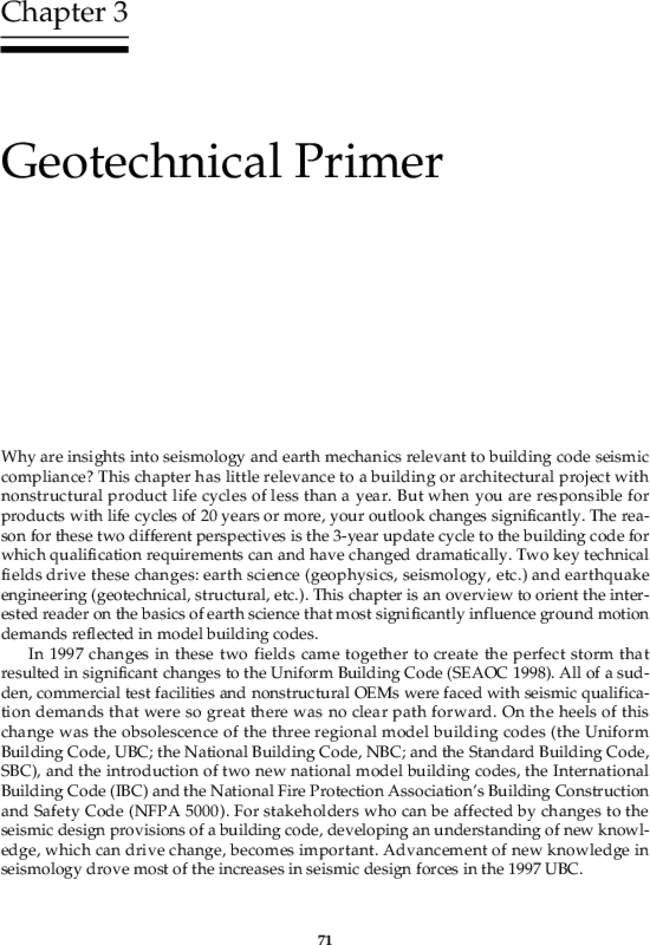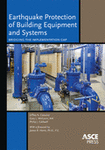Chapter 3
Geotechnical Primer
Publication: Earthquake Protection of Building Equipment and Systems: Bridging the Implementation Gap

Get full access to this article
View all available purchase options and get full access to this chapter.
References
Algermissen, S. T., and Perkins, D. M. (1976). “A probabilistic estimate of maximum acceleration in rock in the contiguous United States.” USGS Open File Report 76-416, USGS, Washington, DC.
ASCE/SEI. (2010). “Minimum design loads for buildings and other structures.” ASCE/SEI 7-10, Reston, VA.
Beavers, J. E. (2002). “A review of seismic hazard description in U.S. design codes and procedures.” J. Prog. Struct. Eng. and Mat., 4(1), 46–63.
Bolt, B. (1993a). “Predicting strong ground shaking.” In Earthquakes and geological discovery, Chapter 7, 152–179. Scientific American Library, New York, NY.
Bolt, B. A. (1993b). Abridged modified Mercalli Intensity Scale, earthquakes: Newly revised and expanded, Appendix C. W. H. Freeman and Co., New York, NY.
Bozorgnia, Y., and Campbell, K. W., eds. (2004). Earthquake engineering: From engineering seismology to performance-based engineering. CRC Press, Boca Raton, FL.
California Department of Conservation. (1992). Special publication 42, California Department of Conservation, Division of Mines and Geology, Sacramento, CA.
California Geological Survey. (1973). Alquist-Priolo special studies zone map, Landers Quadrangle. California Geological Survey, Sacramento, CA.
Cooper, J. D. (1868). Editorial in San Francisco Daily Evening Bulletin, Nov. 3.
Federal Emergency Management Agency (FEMA). (2003). “Design response spectrum: NEHRP recommended provisions for seismic regulations for new buildings and other structures.” FEMA 450, Washington, DC.
Frankel, A. D., et al. (2000). “USGS national seismic hazard maps, earthquake spectra.” J. Earthquake Eng. Res. Inst., 16(1), 1–19.
Frankel, H. (1978). “Arthur Holmes and continental drift.” Br. J. Hist. Sci., 11(2), 130–150.
Hanks, T. C., and Kanamori, H. (1979). “Moment magnitude scale.” J. Geophys. Res., 84(B5), 2348–2350.
Holmes, A. (1945). “Continental drift: The search for a mechanism.” Principles of physical geology, Chapter 21. Ronald Press Co., New York, NY.
International Conference of Building Officials (ICBO). (1998). Maps of known active fault near-source zones in California and adjacent portions of Nevada to be used with the 1997 Uniform Building Code. ICBO, Whittier, CA.
Jacoby, G.C., Sheppard, P.R., and Sieh, K.E. (1988). “Irregular recurrence of large earthquakes along the San Andreas fault: Evidence from trees.” IScience, 241(4862), 196–199.
Jones, L. M., et al. (2008). “The shakeout scenario.” USGS Open File Report 2008-1150, CGS Preliminary Report 25. USGS, Washington, DC.
Kious, J. (2007). “Historical perspective.” USGS: The Dynamic Earth. <http://pubs.usgs.gov/gip/dynamic/historical.html> (Oct. 12, 2011).
Lewis, C. L. E. (2002). “Arthur Holmes: An ingenious geoscientist.” GSA Today, March, 16–17.
National Earthquake Prediction Evaluation Council (NEPEC). (2011). “Independent expert panel on the New Madrid seismic zone earthquake hazards, April 16, 2011.” <http://earthquake.usgs.gov/aboutus/nepec/reports/NEPEC_NMSZ_expert_panel_report.pdf> (Oct. 12, 2011).
Newmark, N. M., and Rosenblueth, E. (1971). Fundamentals of earthquake engineering. Prentice-Hall, Englewood Cliffs, NJ.
Popov, E. (1994). “Development of US seismic codes.” J. Const. Steel Res., 29, 191–207.
Richter, C. F. (1958). Elementary seismology, W. H. Freeman and Co., New York, NY.
Roberts, E. B., and Ulrich, F. P. (1950). “Seismological activities of the U.S. Coast and Geodetic Survey in 1948.” Bull. Seism. Soc. Am., 40, 195–216.
Stover, C., and Coffman, J. L. (1993). “Seismicity of the United States, 1568–1989 (revised).” USGS Professional Paper 1527, USGS, Washington, DC.
Structural Engineers Association of California (SEAOC). (1998). Blue book, ICBO, Whittier, CA.
Topinka, L. (1997). “Active volcanoes, plate tectonics, and the “Ring of Fire.” Online Volcano Maps, USGS/Cascades Volcano Observatory, Vancouver, WA <http://vulcan.wr.usgs.gov/Glossary/PlateTectonics/Maps/map_plate_tectonics_world.html>
U.S. Geological Survey (USGS). (2011a). “Did you feel it?” <http://earthquake.usgs.gov/earthquakes/dyfi/> (Oct. 14, 2011).
U.S. Geological Survey (USGS). (2011b). “Largest and deadliest earthquakes by year.” <http://earthquake.usgs.gov/earthquakes/eqarchives/year/byyear.php> (Oct. 12, 2011).
U.S. Geological Survey (USGS). (2010). <https://geohazards.usgs.gov/secure/designmaps/us/application.php> (Date accessed, 2011).
Vigil, J. F. (1994). “This dynamic planet.” Wall map produced jointly by the U.S. Geological Survey, the Smithsonian Institution, and the U.S. Naval Research Laboratory, Washington, DC.
Wegener, A. (1924). The origin of continents and oceans. Methuen, London.
Wood, H. O., and Neumann, F. (1931). “Modified Mercalli scale of 1931.” Bull. Seism. Soc. Am., 21, 277–283.
Zeng, Y. and Chen, C.-H. (2001). “Fault rupture process of the 20 September 1999 Chi-Chi, Taiwan earthquake.” Bull. Seism. Soc. Am., 91(5), 1088–1098.
Information & Authors
Information
Published In
Copyright
© 2012 American Society of Civil Engineers.
History
Published online: May 31, 2013
ASCE Technical Topics:
Authors
Metrics & Citations
Metrics
Citations
Download citation
If you have the appropriate software installed, you can download article citation data to the citation manager of your choice. Simply select your manager software from the list below and click Download.
